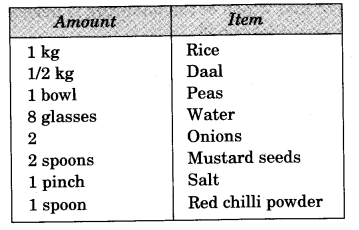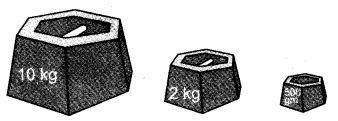Students can use Maths Mela Class 3 Solutions Chapter 8 Fair Share Question Answer to explore alternative problem-solving methods.
Class 3 Maths Chapter 8 Fair Share Question Answer Solutions
Fair Share Class 3 Maths Question Answer
Class 3 Maths Chapter 8 Solutions
Shabnam and Mukta are enjoying their lunch break.

How do you think they are going to share the chocolate and the paratha equally?

Think about a strategy that you can use to check whether two pieces are equal or not.
Let us Discuss

Question 1.
How do you share objects equally?
Answer:
I can share countable objects equally by counting.
Question 2.
Why is Shabnam folding the paratha over itself?
This is a whole paratha.

Tick (✓) the paratha that has been cut equally.

Answer:
Shabnam is sharing the paratha equally by folding the paratha over itself that is making two equal parts.

Let us Do
Question 1.
Circle the shapes where half of the whole is shaded.

Answer:

Question 2.
Draw a line to show one-half of the whole.

Answer:

![]()
Question 3.
Shabnam has eaten some chikki from 3 sides.
Tick (✓) how much chikki is left?
(a) less than half
(b) more than Half
(c) Half

Answer:
(a) less than half
(b) more than Half
(c) Half (✓)
Question 4.
Show by colouring half a chikki that has been eaten from 2 sides.

Answer:

Question 5.
Draw lines to show different ways of making a half.

Answer:

Question 6.
Complete the whole picture by drawing the other half.

Answer:

Let us Explore
Take a rectangular sheet of paper and fold it in half. Find all the different ways to make a half.

Take a square piece of paper and fold it in half. Find all the different ways to make a half.
Let us Discuss
There was an old man with two sons Amit and Bala. He gave a mango tree, a solar lamp and a woollen blanket to them. He asked them to share these things among themselves. Amit was a cunning man. He told his brother βLet us share the objects equally. I will keep the fruits, you keep the tree. I will keep the lamp during the night, you can keep it during the day. I will keep the blanket for half the year during winter. You can keep it for half the year during summer.β Bala agreed. Is this a fair way of sharing? Is there another way to share it fairly?

Let us Do
Here are some mangoes. Share them equally between the two children.

Answer:

Half and double

![]()
Fill in the following blanks using double or half.

Answer:
4 marbles are
half
of 8 marbles
8 marbles are
double
of 4 marbles
10 marbles are
double of
5 marbles
5 marbles are
half
of 10 marbles
6 marbles are
half
of 12 marbles
12 marbles are
double
of 6 marbles.
• On a number line how far is 13 from the double of 7? How far is 5 from half of 14?
Answer:

Double of 7 = 14
13 is one step back from 14.
Half of 14 = 7
5 is two steps back from 7.
Guess who am I?
Use the clues to find the right fraction. Tick the correct box from the given 3 options.
Question 1.
I have less than double of 3 marbles.
I have more than half of 8 marbles.

Answer:

Question 2.
I have less than double of 4 marbles.
I have more than half of 10 marbles.

Answer:

• What part of the chikki did each get?
Answer:
Quarter.
• How many quarters in a whole?
Answer:
4.
Let us Do
Question 1.
Tick (✓) the objects that show quarters.

Answer:

Question 2.
Draw lines to make a quarter of the whole.

Answer:

Question 3.
Draw the remaining three quarters and complete the whole.

Answer:

![]()
Question 4.
Draw the remaining quarters to compete the whole.

Answer:

Half of quarter?
Tick (✓) the objects that show quarters.

Shabnam
![]() has coloured
half/a quarter
of the birds.
has coloured
half/a quarter
of the birds.
Mukta
![]() has coloured
half/a quarter
of the birds.
has coloured
half/a quarter
of the birds.
Shabnam has coloured
half/double
the number of birds that Mukta has coloured.
Answer:

Lakshanya and Peehu have 16 flowers each.

Lakshanya
![]() tied
half/a quarter
of her flowers.
tied
half/a quarter
of her flowers.
Peehu
![]() tied
half/a quarter
of her flowers.
tied
half/a quarter
of her flowers.
Lakshanya
![]() tied
half/double
the number of flowers that Peehu tied.
tied
half/double
the number of flowers that Peehu tied.
Answer:

Quarters and Whole

Let us Do
Question 1.
Tick (✓) the shapes below that show three-quarters.

Answer:

Question 2.
Colour the shapes below to show the fractions as instructed.

Answer:

![]()
Question 3.
Draw lines and colour the shapes below to show the fractions as instructed.

Answer:

Question 4.
Here is a rectangle which shows quarters. Discuss how.

Answer:

Total blocks = 16
4 blocks are orange
4 blocks are blue
4 blocks are green
4 blocks are yellow
4 blocks are one quarter of 16 blocks
So, rectangle is showing quarters.
Question 5.
Show quarters and halves in different ways in the grids given below.

Answer:

Question 6.
Use the fraction cards from your book to form a whole.
Answer:
Do yourself.
NCERT Solutions for Class 3 Mathematics Chapter 8 Who is Heavier? (Old Syllabus)
Gur (Jaggery) and Groundnuts
1.Are the groundnuts really more than the jaggery (gur) in weight or do they just look more?
Ans.
The groundnuts are not really more than the jaggery in weight but they just look more.
2.Now, guess, for which of these you need a bigger bag.
(i)1 kg popcorn or 1 kg sugar?
(ii)1 kg peas or 1 kg potatoes?
Go to the market and check if your guess is right.
Ans.
(i) For 1 kg popcorn, we need a bigger bag.
(ii) For 1 kg peas, we need a bigger bag.
Pumpkin Tomato ‘Panga’
1.How many small tomatoes do you think could lift the pumpkin up?
Ans.
About thirty five to forty small tomatoes are enough to lift the pumpkin up.
2.How many big mangoes can balance the pumpkin?
Ans.
About twenty big mangoes may balance the pumpkin.
3.How many pumpkins can balance you on the see-saw?
Ans.
About ten pumpkins can balance me on the see-saw.
4.Name some of your classmates who you think weigh.
(a)Almost the same as you.————
(b)More than you. ————
(c)Less than you.————
Ans.
(a)Almost same as me: Arjun, Saurav, Swarnim.
(b)More than me: Rahul, Rakesh, Ahmad
(c)Less than me: Ramesh, Suresh, Akhilesh, Shailendra.
5.How many books can you lift on one hand keeping your arm straight?
Ans.
I can lift five books on one hand; keeping my arms straight.
Yum-yum Rice
1.Help him match the things with their right amounts.
Ans.
Correct amount of the things are as follows:

Activity Time
1.Make a list of things bought at your home. Find out how much of each thing is bought at one time. These things can be rice, oil, chilli powder, sugar, milk, onions, ginger, etc.

I.Guess their weigh and match
(i) Brief-case — 10 kg
(ii) Mango – — less than 1 kg
(iii) Cow — 400 kg
(iv) Elephant — more than 1000 kg
(v) Wheat — 80 kg
(vi) Puppy — 2kg
II.Guess which of the following things weigh more than 1 kg? Which ones weighs less than 1 kg?
(i) Your school bag (ii) Geometry box
(iii)A brick (iv) A big pumpkin
(v)Your pair of slippers/shoes.
Ans.
Things which weigh more than 1 kg are
(i) A school bag, (ii) A brick (iii) A pumpkin.
Things which weigh less than 1 kg
(i) Geometry box (ii) Slipper/shoes.
1.Bring a balance and a 1 kg weight to class. Check if your guess was right.
Ans.
On checking by a balance, I found my guess was correct.
2.Use your balance to find which of the following is heavier:
(i)A water bottle or a cricket ball.
(ii)Your shoes or your pencil box.
(iii)Your Maths book or your Hindi book.
(iv)Your bag or your friend’s bag.
Ans.
(i) A cricket ball is heavier than water bottle.
(ii)My shoes are heavier than my pencil box.
(iii)My Maths book is heavier than my Hindi book.
(iv)My bag is heavier than that of my friend.
3.Make a list of:
(i)Things weigh less than half kg.
(ii)Things weigh more than half kg.
Ans.
(i)Things weigh less than half kg are:
Socks, watch, belt, spectacles, slipper, gloves, etc.
(ii)Things weigh more than half kg are:
Fan, chair, table, cot, television, etc.
Look for Weights and Balances
1.Make a trip to your nearest junk dealer, vegetable shop and grocery shop. Have a look at the weights they use. Find out:
(i)Who uses the biggest weight?
(ii)Who uses the smallest weight?
Ans.
(i) A junk dealer uses the biggest weight.
(ii) The smallest weight is used in a grocery shop.
2.Have you seen any of these balances?
Ans.
I have seen each type of these balances.
3.In which shop would you find the following types of weights? Discuss with your friends.

Ans.
I have seen such weights in stores which sell grains.